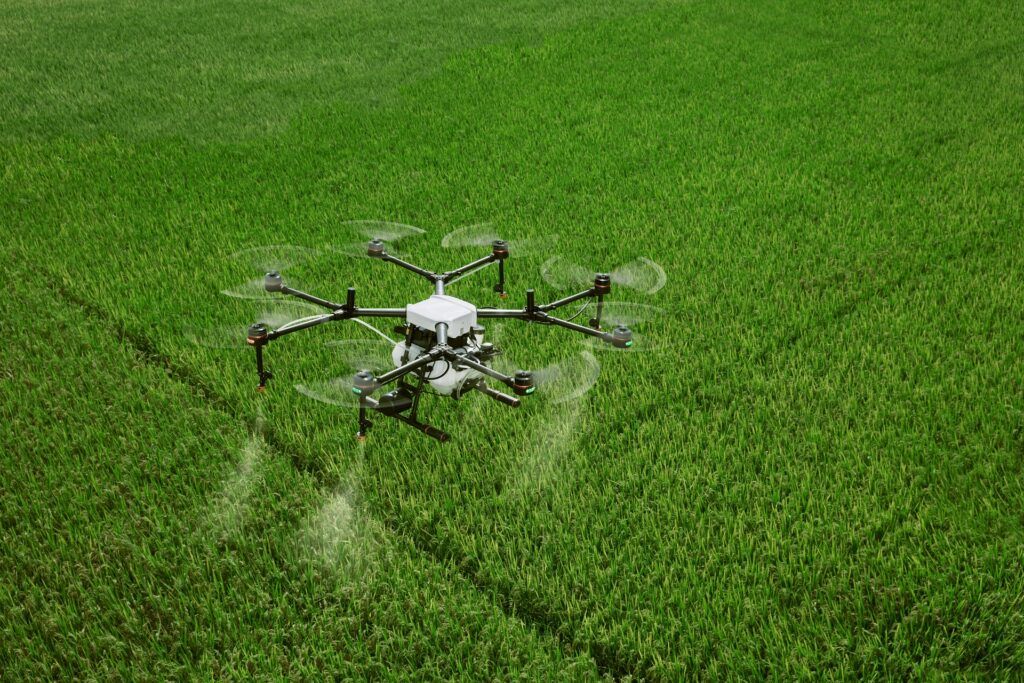Why cheap drones pose a significant chemical terrorism threat
By Zachary Kallenborn | November 21, 2023
 An agricultural drone. Credit: DJI-Agras via Pixabay.
An agricultural drone. Credit: DJI-Agras via Pixabay.
Earlier this year, police in the United Kingdom arrested Mohammad Al-Bared for building a drone designed for the Islamic State, the terrorist group that once held vast territory in Iraq and Syria. The 3D-printed drone was designed to deliver chemical weapons or explosives, and a search of Al-Bared’s home turned up notebooks with chemical equations and “recipes for chemical weapons,” unrelated, according to authorities, to his studies as a doctoral student in mechanical engineering. Al-Bared had developed a plan involving a “spoof company” to ferry his weapon, undetected, into a war zone.
Al-Bared, found guilty in September of preparing acts of terrorism, was certainly not the first would-be terrorist to explore using drones. The history of such planning dates back at least to the Japanese doomsday cult Aum Shinrikyo’s experimentation with uncrewed vehicles in 1993 or 1994 for a use in a possible chemical or biological weapons attack. The group ended up attacking the Tokyo subway system without drones. Since then, drone technology has significantly improved.
Relatively cheap drones are becoming a mainstay of conflicts, from the war in Ukraine to the Israel-Hamas conflict in Gaza. Though drones were once the purview of rich and powerful militaries, it’s now possible to use cheap consumer drones in battle. With a few tweaks, they can whistle past even sophisticated air defenses. As Al-Bared’s case highlights, they may also present a significant chemical terrorism threat. Drones can be equipped with sprayers to deliver chemical weapons, or they could be used in an attack on a chemical plant. They could also provide critical attack support, helping with reconnaissance to plan out and conduct an attack, monitor law enforcement response, and create propaganda to highlight terrorist activities.
Chemical attacks, on the cheap. Drones are great delivery vehicles for chemical weapons. They could fly above crowded areas, say an outdoor concert or a stadium, and spray the agent over the gathered people. Although commercial drones have small payloads that could limit the harm they inflict, low-altitude flights that target dense populations still pose a significant threat.
Commercial agricultural drones are particularly well-designed for chemical weapons delivery. Drones for spraying pesticides come equipped with chemical tanks, pumps, hoses, nozzles, and other equipment capable of handling toxic chemicals. A wannabe terrorist could get the complete package right off the shelf without worry. The drones can run as low as $1,500 and do not require any special license to purchase.
Improvements to drone technology have also increased their effectiveness as chemical weapons delivery systems. Simple hobbyist drones available on Amazon for a few thousand dollars are capable of basic waypoint navigation, autonomously flying a pre-determined route guided by GPS. A terrorist organization could pre-plan spray routes over a gathered crowd, using multiple chemical-spraying drones. In addition, terrorists might incorporate decoy drones—simple, unarmed drones meant to distract law enforcement from the main chemical attack. Also, even commercial drones now can operate in autonomous modes, flying to a target without need of direct connection to the user, rendering defenses meant to jam the connection between drone and operator useless.
Of course, there’s an important challenge any terrorist would face before delivering a chemical weapon via drone: acquisition of a chemical weapon. It would not be a trivial process for a terrorist group to acquire a weapons agent like sarin, VX, or mustard gas. The terrorists would require specialized equipment, chemicals, and facilities, not to mention the know-how to use them. However, as researchers at Harvard Medical School and I have highlighted, fentanyl derivatives could provide a deadly, affordable alternative to traditional weapons agents. In the 1990s, the Department of Defense and Justice studied fentanyl as an incapacitating agent, but concluded it was unsafe because the margins between incapacitating and killing targets were quite small. Now, fentanyl is available easily and broadly on the black market.
A gaping vulnerability. Beyond using drones to directly deliver chemical weapons is another deadly possibility: The use of drones to attack on chemical facilities.
On December 3, 1984, safety failures at the Union Carbide India Limited pesticide facility in Bhopal, India lead to an accidental release of 40 tons of highly toxic methyl isocyanate. The government of Madhya Pradesh, an Indian state, reported that 3,787 people were killed and 574,366 were injured by the accident. Other estimates put the death toll as high as 16,000. Triggering a similar release would be perhaps the easiest way for a terrorist to carry out a mass-casualty chemical attack. Terrorists would not need to acquire any exotic chemical agent; they would need only to detonate enough explosives in the chemical facility to cause a disaster. The Cybersecurity and Infrastructure Security Agency has identified 3,200 “high-risk” chemical facilities in the United States.
Although Congress passed the Chemical Facility Anti-Terrorism Standards in 2006 to require and enforce a variety of security measures at chemical facilities nationally, including mandatory cyber and physical security measures, personnel vetting, and compliance inspections, the law has minimal requirements for protecting against potential aerial attacks. But on July 28, 2023, Congress allowed the one law protecting chemical plants from terrorism to expire. The Cybersecurity and Infrastructure Security Agency can no longer monitor compliance and enforce even the minimum requirements of the now-expired law.
Here’s how drones could make attacks on facilities easier: They can fly over physical barriers at the facility, such as fences, bollards, and gates and drop a bomb on a chemical storage tank, leading to a release. Current federal law does not authorize the private sector to operate drone defeat systems, so the facility would have to identify the threat, contact federal law enforcement, and wait on officer arrival before the threat could be neutralized with a handheld jammer or other device. As even hobbyist drones can fly over a 100 miles per hour, an aggressive attacker would likely be able to succeed.
A terrorist could also use drones to prepare for attacks on chemical facilities. For example, Brenton Tarrant used a drone to conduct reconnaissance on the the Masjid an-Nur mosque in a 2019 attack in Christchurch, New Zealand that killed 51 people. Similarly, a would-be chemical plant attacker could fly the drone around the facility to monitor security officer movements, map the perimeter, look for security cameras, and identify potential avenues of attack either by drone or other forces. Even if facility managers spot the drone and are concerned, they may write it off as a careless hobbyist or perhaps a lawless rival.
What should be done. To mitigate the threat, Congress needs to reauthorize the Chemical Facility Anti-Terrorism Standards program. Chemical plants need to have robust security standards, enforced by federal agencies. Congress should also update the standards with new requirements for aerial situational awareness, such as establishing sensor networks and participating in information sharing systems like the Federal Aviation Administration’s plan for an unmanned traffic management system. As commercial drones become more ubiquitous, providing chemical facility owners and operators with information about friendly drone behavior will be helpful in knowing which drones they do not need to worry about.
Congress should also require purchasers of agricultural drones over 55 pounds to receive a Federal Aviation Administration certification prior to purchase. Part 137 UAS certification is already required for operating agricultural drones, so the impact on legitimate purchasers should be minimal. In addition, state, local, and federal law enforcement agencies should monitor for extremist interest in agricultural drones. A known terrorist group attempting to acquire such a drone or multiple conventional drones should set off red flags and warrant further investigation. That could include partnering with drone manufacturers like PrecisionHawk or Hylio to identify and share information about suspicious transactions. The global community should also consider export controls and relevant monitoring of agricultural drones with particularly high-capacity storage tanks. These might be brought into international agreements like the Australia Group, an arrangement among countries, including the United States, that seeks to coordinate export rules to prevent the proliferation of chemical or biological weapons.
For potential chemical terrorists, drones are quite the boon. They could serve as cheap, novel, and effective delivery systems. Or they could carry out attacks on chemical facilities, jumping over ground-based defenses. Or they might support reconnaissance before an attack or film the results. Thwarting chemical terrorism will require new initiatives that consider the growing popular uses for drones. Like the regulatory and technical advances that will allow for safe large-scale drone delivery and other operations, these could take a while to implement. At the very least, policymakers should avoid increasing the risks of chemical terrorism, for example, by letting the only US program meant to secure chemical facilities from attacks lapse. Though in Congress these days, that could be a tall order.
Together, we make the world safer.
The Bulletin elevates expert voices above the noise. But as an independent nonprofit organization, our operations depend on the support of readers like you. Help us continue to deliver quality journalism that holds leaders accountable. Your support of our work at any level is important. In return, we promise our coverage will be understandable, influential, vigilant, solution-oriented, and fair-minded. Together we can make a difference.
Keywords: chemical weapons, drones
Topics: Biosecurity














